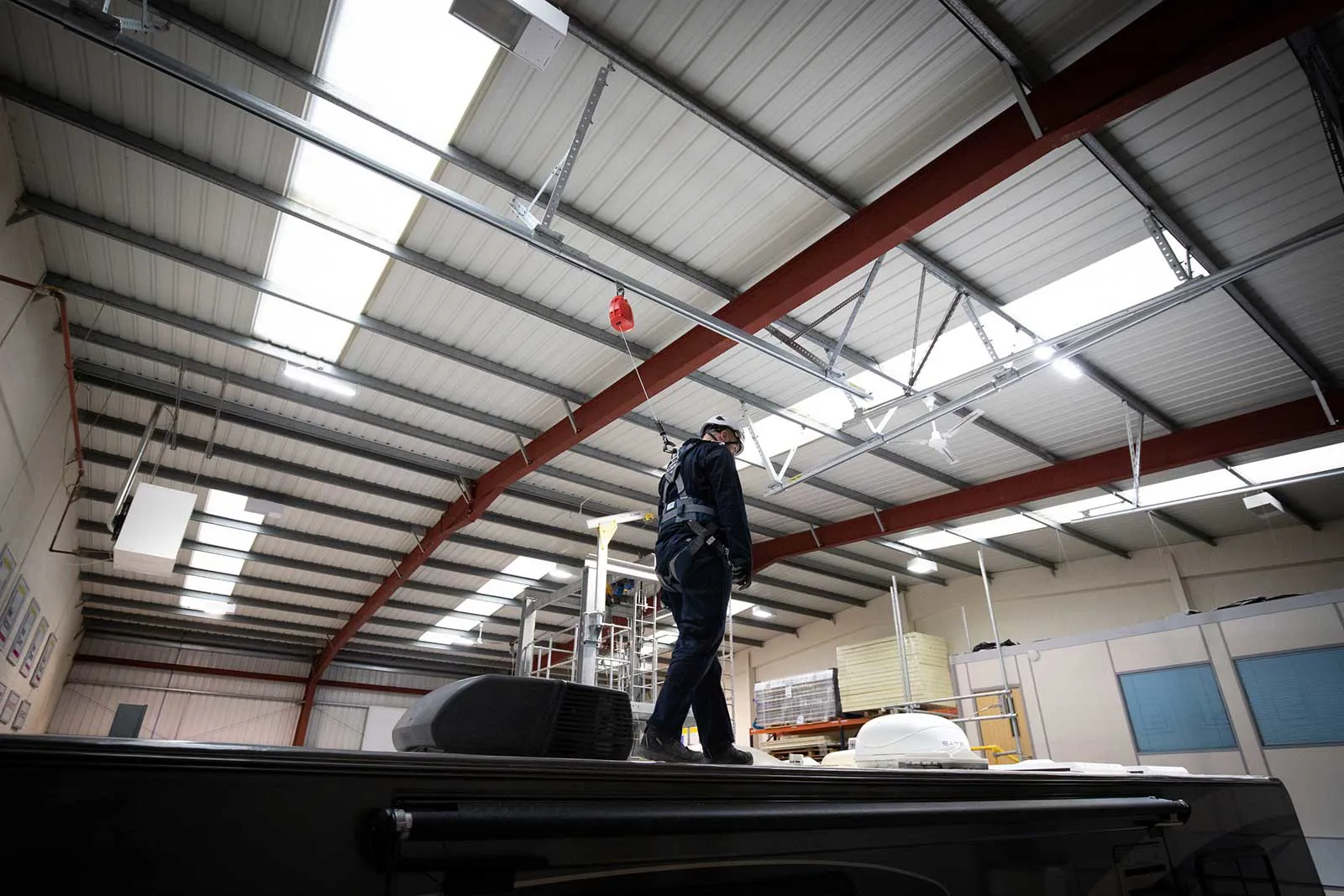
You are visiting the United Arab Emirates Kee Safety website from United States. Would you like to go to the United States site?
The Hierarchy of Fall Protection is an important part of planning any work at height activity and will help you to prioritise and select the most appropriate fall prevention system. The best way to protect people is to design out the need to work at height in the first place and this is the first layer of the Hierarchy of Fall Protection. Pretty obvious isn’t it, but many people overlook this option, and in many cases, it simply isn’t possible. Here we move to the second layer that suggests we use collective equipment to protect our workers, such as guardrails and barriers. As you work your way down the hierarchy, the last option is to minimise the distance that someone will fall by using protection equipment such as a fall arrest system.
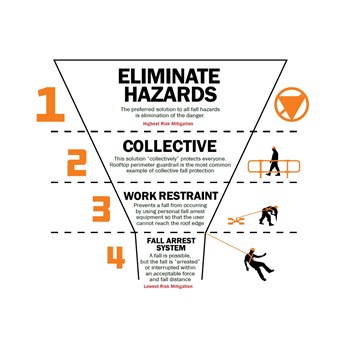
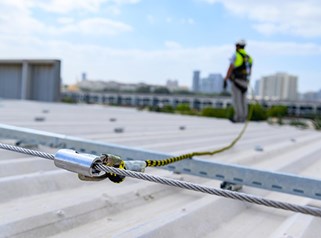
When you mention a “fall arrest system”, people tend to think of a horizontal lifeline that protects someone close to the leading edge of a roof. Horizontal fall arrest systems are designed to reduce the force placed on the person and anchor during a fall and decelerate the user or worker safely over a specific distance. However, there are several factors to consider, including the height of the anchor point in relation to the worker, the length of the lanyard, and the height and weight of the person using the equipment. All these factors affect the required free fall distance needed to safely arrest a person’s fall from height. Invariably the distance required to arrest the fall safely and prevent them from hitting the ground or obstruction below will need to be considerable.
There’s no question that a horizontal fall arrest system can protect those working on a rooftop and where there is a substantial fall distance. However, there are situations where the required fall clearance is simply not available or the application is not practical for it to be installed, such as an employee working on top of a dairy tanker or a maintenance worker walking on the wings of an airplane. In these cases, an overhead fall arrest system presents the best alternative.
As with horizontal fall arrest, an overhead system provides continuous handsfree protection for the user and is ideal for low-clearance applications such as loading lorries, working on vehicles, aircraft, and trains, or for external building works such as façade maintenance.
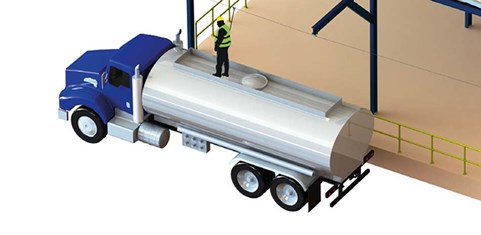
The principal aim of an overhead system is to provide workers with an anchor point directly above their head to provide a means to safely arrest a fall and within a short distance as possible. This can be done by using either a cable-based or rigid track-based system.
An overhead cable system can also be referred to as an overhead horizontal lifeline system. As the name suggests, the main feature is a cable or wire that is fixed to a suitable structure such as a wall, beam, or ceiling. A track system on the other hand is a permanently installed overhead rigid rail that can be secured to internal roof structures such as beams, trusses, and concrete. Both provide users with continual, hands-free fall protection throughout the entire length of the system.
Overhead fall arrest systems can be used in a wide range of industrial and commercial applications where fall clearance is a concern, or when floor space needs to be kept clear and open for operational purposes. For example:
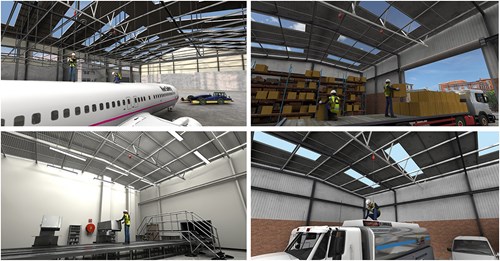
Above are some examples of overhead fall arrest systems applications. Which system you should use will depend on where the system is to be installed, the layout required, the number of users, and of course the fall clearance available.
Overhead lifeline systems normally feature a highly tensioned cable that spans the work area and is fixed to anchor points at both ends. Permanently attached trollies allow users to travel and work freely whilst connected to the line without needing to disconnect from the system as they pass over intermediate brackets.
Overhead lifeline systems tend to be designed for up to 3 users and are ideal for situations where a fall arrest system needs to be mounted directly above a work area. The flexible design of these cable-based systems means they can cope with changes in height or direction and the fixation points can span large distances, meaning they are typically cost-effective and quick to install.

One big disadvantage of overhead cable systems is the larger fall clearance distance required in comparison to the rigid rail system. The 8mm stainless steel wire rope that is typically used by these systems has a higher degree of flexibility and will therefore deflect more under load than a rigid rail system. This in the industry is known as “sag” and there are two main types we refer to; one is initial sag and the other is dynamic sag. Initial sag comes from the weight of the system trolley, self-retracting lifeline (SRL), and the weight of the wire rope. Dynamic sag is caused by the impact load which is applied to the system in the event of a fall. Initial sag is depicted below in point 1 and dynamic sag in point 3.

The image above represents a fall on a cable-based overhead fall protection system and rigid rail fall protection system. 1/ Worker using cable-base overhead fall protection – Initial Sag can be seen. 2/ Second worker is suspended in the air from the tension in the line caused by a fallen worker. 3/ Fall worker using a cable-based overhead system, Dynamic Sag can be seen. 4/ Fall worker using a rigid rail overhead fall protection system – no Dynamic Sag in the system. 5/ Worker using a rigid rail overhead fall protection – no Initial Sag in the system.
Overhead rail systems house anchor points, known as travelers, that run along the length of the rail providing hands-free movement to multiple users at any one time. Like overhead cable systems, rigid rail fall protection allows workers to move freely around a wide working area. Their modular design means they can easily accommodate awkward layouts and be configured around obstacles such as ventilation systems, ducting, and pipework.
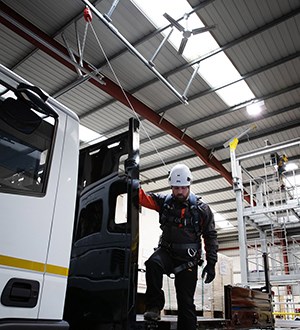
Rigid rail systems by design do not have any sags and as such can be used in lower clearance areas. Unlike cable fall protection, rigid rails have limited deflection, which limits free-fall. During a fall arrest scenario with a cable lifeline, cable sag causes the traveller to slide to the center point of the nearest support. This motion can cause a worker to hit walls and nearby structures during or after a fall. In addition to reduced deflection rates, rigid rail systems are better suited than cable systems for accommodating multiple users.
Low clearance applications, such as working on top of containers and flatbed trucks require the use of a rigid rail system and quick stopping self-retracting lanyard. Performing maintenance on top of equipment used for manufacturing and distribution processes can also be hazardous. Often the equipment can have access points that require someone to work in an unsafe position. A rigid rail system can provide safe, consistent access to areas that would otherwise be considered high risk and therefore unsafe.
The flexibility of these systems means they can be added to, moved, and reconfigured when necessary. For example, some products can even be erected as a stand-alone system externally with structurally sound footers and beams.
Before specifying an overhead rail, you need to be sure that the building can accommodate the anticipated load of the fall arrest system. Traditional systems are fixed to primary steel, however more advanced models allow the protection to be attached directly to secondary steel. Advanced models eliminate the need for additional beams, dramatically reduce the potential disruption on-site during installation, and therefore open up more opportunities for usage.
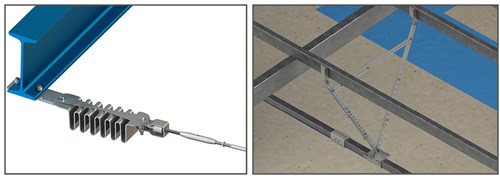
The simple answer to this is neither. Each system has its benefits and which one you choose will depend on aspects including the application, the environment, and how many workers need to use to be attached at any one time.
If the building’s layout requires a versatile system that can accommodate changes in direction, around corners for example, then a cable system provides the perfect solution for these configurations. As you would expect, a rigid rail system is restricted to a straight-line installation so would not be suitable in these cases.
When using an overhead cable system, you need to be aware of deflection that would occur in the event of a fall. As cables are flexible, if someone falls more force is applied to both the person’s body and the anchor point during the process of arresting the fall. As the system slows the persons fall, the cable will deflect under the additional load which will increase the distance before the fall is stopped. If other users are attached to the cable, the sudden system deflection and potential swinging pendulum effect caused by the person falling may cause other users to fall as well, putting an even greater strain on the cable and further increasing fall distance.
Deflection is of course something we consider when specifying an overhead cable system, but there are so many other influences that need to be thought about, such as the weight of any potential user and the equipment they will be carrying. These can have serious implications when the fall distance is very limited or where there are obstructions, and this will determine the type of system that should be used.
For example, when it comes to aircraft maintenance, wings are close to the ground and can present issues with fall clearance. A rigid rail would be the better option in this application as it does not deflect in the same way, which means if a person does slip, their fall will be arrested within a shorter distance which significantly reduces the possibility of injury or expensive repairs to the aircraft.
System |
Fall Protection |
Cost |
No. of Users |
Configuration |
|---|---|---|---|---|
Rigid Rail Systems |
Stops a fall with a shorter drop. This can be critical when working on sensitive equipment. | Requires more initial expense but requires less maintenance and replacement over time. | Can be configured to allow for multiple users to work simultaneously. | Restricted to straight line installation. |
|
|
|
|||
Cable Systems |
Falls can cause a "V" deflection with potential of user injury and equipment damage. |
Less initial expense but subject to more wear and tear, and requires more frequent inspections. |
Usually limited to a maximum of three users at any one time. |
Can flow around corners and up and down height deviations. |
As you can see, when properly designed, engineered, installed, and maintained, both cable and rigid rail overhead systems are capable of providing reliable and compliant fall protection solutions.
However, as with any safety-critical application, you need to make sure you have the right equipment and the knowledge to be able to use it effectively, not only for the safety of those carrying out the work but also for other people working in the same vicinity. The word here is competence and any person designing, installing, or using these systems should be able to demonstrate they are suitably trained, and able to carry out the works.
You should always seek professional advice from a competent person or company when it comes to specifying fall protection equipment, as the correct specification will be based on several important factors. If you get any of these wrong, you could be putting both your workers and your business at risk.
We at Kee Safety understand the complexities associated with designing effective and compliant fall protection systems and are very happy to provide advice and guidance to ensure the correct solutions are implemented and in line with your project-specific requirements.